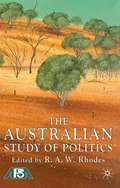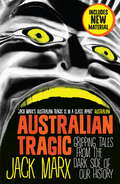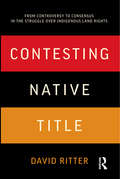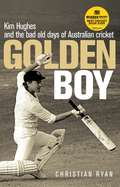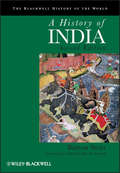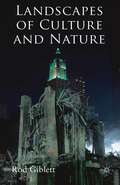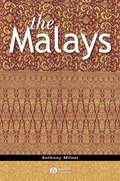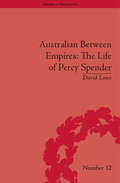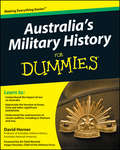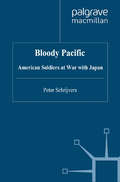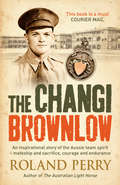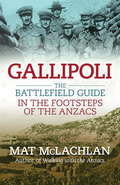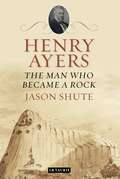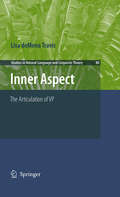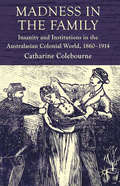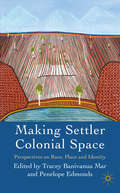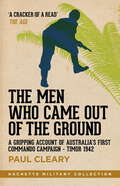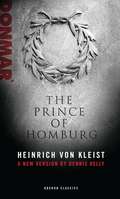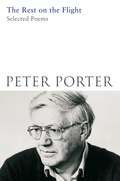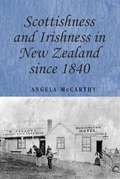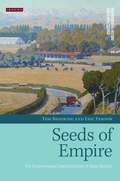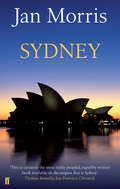- Table View
- List View
The Australian Study of Politics
by R. RhodesThe Australian Study of Politics provides the first comprehensive reference book on the history of the study of politics in Australia, whether described as political studies or political science. It focuses on Australia and on developments since WWII, also exploring the historical roots of each major subfield.
Australian Tragic: Gripping tales from the dark side of our history
by Jack MarxA compelling collection of tales from Australia's dark heart - of catastrophe and misfortune, intrigue and passion, betrayal and tragedy.AUSTRALIAN TRAGIC ranges across our past and our present: the heartbreaking story of the fire at Luna Park; the unstoppable opportunist who snatched innocent men and women from Palm Island to be part of P. T. Barnum's 'Greatest Show on Earth'; a world-class boxer who lost his battle with alcohol and ended up in an unmarked American grave; a man who heroically survived a war to find himself crushed and defeated by events much closer to home; and a new story - of an echo from Ned Kelly at Stringybark Creek, in our own time ... Heartbreaking and shocking, gothic and weird, these fascinating stories are all true, and told to remind us of the Australia we don't know, the one that simmers with love and hate, of hopes raised and futures dashed, unheralded and unnoticed . . . until now.
Contesting Native Title: From controversy to consensus in the struggle over Indigenous land rights
by David Ritter'This book debunks in spectacular fashion some of the most treasured, over-inflated claims of the benefits of native title.'Professor Mick Dodson, ANU Centre for Indigenous Studies'David Ritter's fascinating account of the evolution of the native title system is elegant and incisive, scholarly and sceptical; above all, unfailingly intelligent.'Professor Robert Manne, La Trobe University'An unsentimental, richly informed account of a fascinating period in the history of Australia's relationships with its indigenous people.' From the Foreword by Chief Justice Robert FrenchAfter the historic Mabo judgement in 1992, Aboriginal communities had high hopes of obtaining land rights around Australia. What followed is a dramatic story of hard-fought contests over land, resources, money and power, yielding many frustrations and mixed outcomes. Based on extensive research, enriched by intimate experience as a lawyer and negotiator, David Ritter offers both an insider's perspective and a cool-headed and broad-ranging account of the native title system. In lucid prose Ritter examines the contributions of the players that contested and adjudicated native title: Aboriginal leaders and their communities, multinational resource companies, pastoralists, courts and tribunals, politicians and bureaucrats. His account lays bare the conflicts, compromises and conceits beneath the surface of the native title process.
Contesting Native Title: From controversy to consensus in the struggle over Indigenous land rights
by David Ritter'This book debunks in spectacular fashion some of the most treasured, over-inflated claims of the benefits of native title.'Professor Mick Dodson, ANU Centre for Indigenous Studies'David Ritter's fascinating account of the evolution of the native title system is elegant and incisive, scholarly and sceptical; above all, unfailingly intelligent.'Professor Robert Manne, La Trobe University'An unsentimental, richly informed account of a fascinating period in the history of Australia's relationships with its indigenous people.' From the Foreword by Chief Justice Robert FrenchAfter the historic Mabo judgement in 1992, Aboriginal communities had high hopes of obtaining land rights around Australia. What followed is a dramatic story of hard-fought contests over land, resources, money and power, yielding many frustrations and mixed outcomes. Based on extensive research, enriched by intimate experience as a lawyer and negotiator, David Ritter offers both an insider's perspective and a cool-headed and broad-ranging account of the native title system. In lucid prose Ritter examines the contributions of the players that contested and adjudicated native title: Aboriginal leaders and their communities, multinational resource companies, pastoralists, courts and tribunals, politicians and bureaucrats. His account lays bare the conflicts, compromises and conceits beneath the surface of the native title process.
Golden Boy: Kim Hughes and the bad old days of Australian cricket
by Christian Ryan**Voted Wisden Cricket Monthly's best cricket book ever in 2019**WINNER, BEST CRICKET BOOK, BRITISH SPORTS BOOK AWARDS 2010_________________Golden Boy is a blistering exposé of the tumultuous Lillee/Marsh/Chappells era of Australian cricket, as viewed through the lens of flawed genius Kim Hughes._________________Kim Hughes was one of the most majestic and daring batsmen to play for Australia in the last 40 years. Golden curled and boyishly handsome, his rise and fall as captain and player is unparalleled in cricketing history. He played several innings that count as all-time classics, but it's his tearful resignation from the captaincy that is remembered.Insecure but arrogant, abrasive but charming; in Hughes' character were the seeds of his own destruction. Yet was Hughes' fall partly due to those around him, men who are themselves legends in Australia's cricketing history? Lillee, Marsh, the Chappells, all had their agendas, all were unhappy with his selection and performance as captain - evidenced by Dennis Lillee's tendency to aim bouncers relentlessly at Hughes' head during net practice.Hughes' arrival on the Test scene coincided with the most turbulent time Australian cricket has ever seen - first Kerry Packer's World Series Cricket, then the rebel tours to South Africa. Both had dramatic effects on Hughes' career. As he traces the high points and the low, Christian Ryan sheds new and fascinating light on the cricket - and the cricketers - of the times.
A History of India
by Burton SteinThis new edition of Burton Stein's classic A History of India builds on the success of the original to provide an updated narrative of the development of Indian society, culture, and politics from 7000 BC to the present. New edition of Burton Stein’s classic text provides a narrative from 7000 BC up to the twenty-first century Includes updated and extended coverage of the modern period, with a new chapter covering the death of Nehru in 1964 to the present Expands coverage of India's internal political and economic development, and its wider diplomatic role in the region Features a new introduction, updated glossary and further reading sections, and numerous figures, photographs and fully revised maps
Landscapes of Culture and Nature
by R. GiblettA bold and exciting exploration of the relationship and interactions between humans, the human landscape and the earth, looking at a diverse range of case studies from the nineteenth-century city to the Asian tsunami and Hurricane Katrina.
The Malays (The Peoples of South-East Asia and the Pacific)
by Anthony MilnerJust who are ‘the Malays’? This provocative study poses the question and considers how and why the answers have changed over time, and from one region to another. Anthony Milner develops a sustained argument about ethnicity and identity in an historical, ‘Malay’ context. The Malays is a comprehensive examination of the origins and development of Malay identity, ethnicity, and consciousness over the past five centuries. Covers the political, economic, and cultural development of the Malays Explores the Malay presence in Brunei, Singapore, Indonesia, Thailand, Cambodia, Sri Lanka, and South Africa, as well as the modern Malay show-state of Malaysia Offers diplomatic speculation about ways Malay ethnicity will develop and be challenged in the future
Australian Between Empires: The Life Of Percy Spender (Empires in Perspective #12)
by David LowePart biography, part transnational history, this study details the life and career of Percy Spender, one of Australia's most prominent twentieth-century political figures.
Australian Between Empires: The Life of Percy Spender (Empires in Perspective)
by David LowePart biography, part transnational history, this study details the life and career of Percy Spender, one of Australia's most prominent twentieth-century political figures.
Australia's Military History For Dummies
by David HornerCreated especially for the Australian customer! The simple and easy way to get your mind around Australia's military history More people are visiting Gallipoli and walking the Kokoda Trail each year — now find out why. This complete guide helps you trace the story of Australia's involvement in war, from the colonial conflicts with the Indigenous population, through the World Wars to peacekeeping initiatives in East Timor and the controversial conflict in Afghanistan. Find out the origins of Australia's military history — go all the way back to the arrival of the First Fleet and the conflicts with the Indigenous peoples Learn about the heroism of the Anzacs — discover the origins of the legend of Gallipoli, and how the brass bungled the campaign Discover the horrors of war — consider the suffering and huge losses on the Western Front Recognise the successful battles of World Wars I and II — follow the Diggers' exploits in Palestine and Syria, and at Tobruk and Alamein Marvel at the grim jungle battles — track the Diggersthrough New Guinea, Borneo, Malaya and Vietnam between 1942 and 1972 Admire Australia's efforts to repel possible invaders — learn how Australians defended their country against the Japanese during World War II See how the Cold War heated up — witness the fight against communism in the Korean and Vietnam Wars Appreciate the modern-day Australian Defence Force — acknowledge the courage of the men and women who protectus into the 21st century Open the book and find: New insights into the meaning of Anzac Day Simple explanations of the structure of Australia's military Details of who fought whom, where, when and why Stories of Australia's great military fighters and leaders Accounts of the iconic battles that established Australia's reputation Locations of Australia's peacekeeping operations around the world Ways in which war and conflict have shaped the nation Reasons why Australia goes to war Learn to: Comprehend the impact of waron Australia Appreciate the heroism at AnzacCove and other significant battlefields Understand the controversies ofrecent conflicts, including in Vietnam and Iraq
Australia's Military History For Dummies (For Dummies Ser.)
by David HornerCreated especially for the Australian customer! The simple and easy way to get your mind around Australia's military history More people are visiting Gallipoli and walking the Kokoda Trail each year — now find out why. This complete guide helps you trace the story of Australia's involvement in war, from the colonial conflicts with the Indigenous population, through the World Wars to peacekeeping initiatives in East Timor and the controversial conflict in Afghanistan. Find out the origins of Australia's military history — go all the way back to the arrival of the First Fleet and the conflicts with the Indigenous peoples Learn about the heroism of the Anzacs — discover the origins of the legend of Gallipoli, and how the brass bungled the campaign Discover the horrors of war — consider the suffering and huge losses on the Western Front Recognise the successful battles of World Wars I and II — follow the Diggers' exploits in Palestine and Syria, and at Tobruk and Alamein Marvel at the grim jungle battles — track the Diggersthrough New Guinea, Borneo, Malaya and Vietnam between 1942 and 1972 Admire Australia's efforts to repel possible invaders — learn how Australians defended their country against the Japanese during World War II See how the Cold War heated up — witness the fight against communism in the Korean and Vietnam Wars Appreciate the modern-day Australian Defence Force — acknowledge the courage of the men and women who protectus into the 21st century Open the book and find: New insights into the meaning of Anzac Day Simple explanations of the structure of Australia's military Details of who fought whom, where, when and why Stories of Australia's great military fighters and leaders Accounts of the iconic battles that established Australia's reputation Locations of Australia's peacekeeping operations around the world Ways in which war and conflict have shaped the nation Reasons why Australia goes to war Learn to: Comprehend the impact of waron Australia Appreciate the heroism at AnzacCove and other significant battlefields Understand the controversies ofrecent conflicts, including in Vietnam and Iraq
Bloody Pacific: American Soldiers at War with Japan
by P. SchrijversBased on countless diaries and letters, Schrijvers recounts American GIs' experiences in Asia and the Pacific. From the daunting spaces of the China-India theatre to the fortress islands of Iwo Jima and Okinawa, he brings to life their struggle with suffocating wilderness, devastating diseases, and Japanese soldiers who preferred death over life.
The Changi Brownlow: An Inspirational Story Of The Aussie Spirit (Hachette Military Collec Ser.)
by Roland PerryThis is the moving, powerful and surprising story of a group of Australian POWs who organise an Australian Rules Football competition under the worst conditions imaginable - inside Changi prison.After Singapore falls to the Japanese early in 1942, 70 000 prisoners including 15 000 Australians, are held as POWs at the notorious Changi prison, Singapore. To amuse themselves and fellow inmates, a group of sportsmen led by the indefatigable and popular ‘Chicken’ Smallhorn, created an Australian Football League, complete with tribunal, selection panel, umpires and coaches. The final game of the one and only season was between ‘Victoria’ and the ‘Rest of Australia’, which attracted 10 000 spectators, and a unique Brownlow Medal was awarded in this unlikely setting under the curious gaze of Japanese prison guards.Meet the main characters behind this spectacle: Peter Chitty, the farm hand from Snowy River country with unfathomable physical and mental fortitude, and one of eight in his immediate family who volunteered to fight and serve in WW2; ‘Chicken’ Smallhorn, the Brownlow-medal winning little man with the huge heart; and ‘Weary’ Dunlop, the courageous doctor, who cares for the POWs as they endure malnutrition, disease and often inhuman treatment.Changi Brownlow is a story of courage and the invincibility of the human spirit, and highlights not only the Australian love of sport, but its power to offer consolation in times of extreme hardship.
Gallipoli: The battlefield guide
by Mat McLachlanThe essential travel companion for anyone visiting Gallipoli.Each year, thousands of Australians visit Gallipoli to pay homage and see where their forebears fought, suffered and died. Anzac Cove, Quinn's Post, Lone Pine - the iconic places where our national legend was forged.In this essential and authoritative guide, practical information is combined with historical detail, alongside revealing and often heartrending quotes from the letters and diaries of the Anzacs themselves.- Detailed easy-to-follow plans for walking and driving tours across the main battlefields- Maps, photos and historical commentary to put the campaign in context- Everything you need to know where to go, where to stay and how to get there.Walk where the Anzacs walked, see where they fought and marvel at their courage.
Henry Ayers: The Man Who Became a Rock
by Jason Shute'The most wonderful natural feature I have ever seen.' With these words William Gosse expressed the awe he and many others have felt at the natural phenomenon of Uluru. The first white person to reach the central Australian monolith, he gave it the name Ayers Rock. But who was Henry Ayers, the man whose name is forever associated with Australia's most recognisable natural icon? What did he do to deserve this accolade? And why should historians of Australia and the Empire still remember him today?Although the Rock's ancient indigenous name, Uluru, has now been restored, in place of the nineteenth-century version, the name of Ayers is still recognisable well over a century after the Rock's 'discovery' in 1873. Indeed, the rock that bore his name is one of the most famous natural wonders on earth and attracts over 400,000 visitors every year. This book - the first biography of Henry Ayers - focuses attention on the man behind the name and examines all aspects of his life - as a migrant from the naval town of Portsmouth in southern England, miner, businessman and politician - both public and private. Henry Ayers was a complex character who played an integral and leading role in the development of the then British Province of South Australia. Despite landing amidst the colony's first depression, Ayers went on to win the Secretaryship of the South Australian Mining Association in 1845 and forged a successful career based on the wealth of the 'Monster' copper mine at Burra Burra, north of Adelaide. Jason Shute describes how Ayers made his way from humble origins to South Australia's parliament and ultimately achieved the highest elected office of the South Australian polity, as its Premier, no fewer than seven times. Shute also illuminates Ayers' personal life: his relationships with his wife and children; his tempestuous friendship and rivalry with Henry Rymill, a relative of the wealthiest shareholder in the Burra Burra mine; and his defining connection with William Gosse, the explorer and surveyor, who esteemed him so highly that he honoured him with the connection for which he is remembered internationally.This biography places the life of this prominent Australian figure in the context of Australia's colonial history and charts the development of the province of South Australia. It offers a vivid portrait of a man who was consistently in the upper echelons of influence and authority in southern Australia and whose legacy lives on in the name of one of the most famous and recognisable wonders of the world.
Inner Aspect: The Articulation of VP (Studies in Natural Language and Linguistic Theory #80)
by Lisa deMena TravisFinishing this book was one of the most difficult things I have ever done. It took far too long from original idea to page proofs and suffered from being relegated to small corners of my life. It was very rarely on the front burner. Since I started working on this topic in 1991, there has been a lot of interesting work done on the areas of the articulation of VP, phrase structure mirroring event structure, the use of functional categories to represent Aktionsart, and many other areas that the research presented here touches on. The hardest thing about doing a project of this size is to accept that not everyone’s ideas can be addressed and not all new research can be incorporated. The only way that I have found it possible to let this book go to press is to reread the Preface to Events in the Semantics of English by Terence Parsons where he writes, ‘‘The goal of this book is neither completeness nor complete accuracy; it is to get some interesting proposals into the public arena for others to criticize, develop, and build on. ’’ My aim in this book is to make connections between various accounts of various constructions in various languages at the risk of treating each of these too lightly. I am grateful to too many people to thank them individually.
Madness in the Family: Insanity and Institutions in the Australasian Colonial World, 1860–1914
by C. ColeborneMadness in the Family explores how colonial families coped with insanity through a trans-colonial study of the relationships between families and public colonial hospitals for the insane in New South Wales, Victoria, Queensland and New Zealand between 1860 and 1914.
Making Settler Colonial Space: Perspectives on Race, Place and Identity
by Tracey Banivanua Mar P. EdmondsCharts the making of colonial spaces in settler colonies of the Pacific Rim during the last two centuries. Contributions journey through time, place and region, and piece together interwoven but discrete studies that illuminate transnational and local experiences - violent, ideological, and cultural - that produced settler-colonial space.
The Men Who Came Out of the Ground: A gripping account of Australia's first commando campaign
by Paul Cleary'This account . . . is breathtaking in its scope and riveting in its research' - Sydney Morning HeraldThe gripping story of a small force of Australian Special Forces commandos that launched relentless hit and run raids on far superior Japanese forces in East Timor for most of 1942.These Australians were the men of the 2/2nd Australian Independent Company - a special commando unit. Initially stranded without radio contact to Australia, the Japanese declared these bearded warriors ‘outlaws’ and warned they would be executed immediately if captured. The Australians drawn mainly from the bush, were chosen for their ability to operate independently and survive in hostile territory. As film-maker Damien Parer said after visiting in Timor in late 1942, ‘these men are writing an epic of guerrilla warfare’.Expertly researched by Paul Cleary, who is fluent in Tetum, the main language of the indigenous group of East Timor, it also contains insightful black and white photos.'A cracker of a read' - The Age'Paul Cleary has brought to life one of the great success stories of World War II' - Daily Telegraph
Prince of Homburg (Oberon Modern Plays)
by Dennis KellyHeroic commander of the Prussian cavalry, the Prince of Homburg dreams of victory, glory and fame. But reckless disobedience during a crucial military operation leads the Prince into his greatest battle yet. The creative team behind the Donmar’s critically acclaimed production of Life Is A Dream present Von Kleist’s poetic masterpiece, which is considered to be one of the most haunting and beautiful plays of the nineteenth century, exploring honour, courage, ambition and love. Adapted for stage by acclaimed British writer Dennis Kelly, this is an exciting new adaptation of a classic of European literature.
The Rest on the Flight: Selected Poems
by Peter PorterSatirist, philosopher, elegist, aphorist, cultural historian – Peter Porter is perhaps too singular a talent to be described as ‘representative’ of the age: an Australian whose easy familiarity with the breadth of European culture puts most Europeans to shame, he has long held the reputation of one of our most intellectually promiscuous and culturally sophisticated writers. Porter uses the poem as a means through which a thought can be pursued; this selection from fifty years’ work allows us the first opportunity to fully survey the quality and breadth of that thought, and the unfailing intensity of its light. In short, his Selected Poems is a one-volume education: Porter’s subtle and profound sense of history permits him to read any event as a point in a dynamic space where the forces of time and culture converge. From these coordinates, he gives perspective, direction and bearing to our contemporary life, and allows us to read the pattern of our ideas, art and loves on the map of an ancient terrain. That he has done all this with such immense good humour and human compassion is one of the literary miracles of our time.
Scottishness and Irishness in New Zealand since 1840 (Studies in Imperialism)
by Angela McCarthyThis book examines the distinctive aspects that insiders and outsiders perceived as characteristic of Irish and Scottish ethnic identities in New Zealand. When, how, and why did Irish and Scots identify themselves and others in ethnic terms? What characteristics did the Irish and the Scots attribute to themselves and what traits did others assign to them? Did these traits change over time and if so how? Contemporary interest surrounding issues of ethnic identities is vibrant. In countries such as New Zealand, descendants of European settlers are seeking their ethnic origins, spurred on in part by factors such as an ongoing interest in indigenous genealogies, the burgeoning appeal of family history societies, and the booming financial benefits of marketing ethnicities abroad. This fascinating book will appeal to scholars and students of the history of empire and the construction of identity in settler communities, as well as those interested in the history of New Zealand.
Seeds of Empire: The Environmental Transformation of New Zealand (Environmental History and Global Change)
by Tom Brooking Eric PawsonThe traditional image of New Zealand is one of verdant landscapes with sheep grazing on lush green pastures. Indeed, as far back as the nineteenth century, promotional literature declared its soils to be rich, its weather invariably benign; whilst artists' paintings bathed it in an almost subtropical glow. Such representations, however, were at best partial, at worst unrealistic, for this landscape is almost entirely an artificial creation.The transformation of the New Zealand landscape took place as Britain became increasingly reliant on its overseas territories for supplies of food and raw material. All over the Empire indigenous plants were replaced with 'English grasses', to provide the worked up products of pasture - meat, butter, cheese, wool and hides. These 'seeds of empire' were in the vanguard of colonial development and in New Zealand this process was carried to an extreme as swamps were drained and hundreds of thousands of hectares of rain forest were burnt and re-seeded with imported grasses. Seeds of Empire provides an innovative and challenging look at the impact of this European settlement and development of New Zealand's landscape and environment. In exploring how, why and with what consequences New Zealand was transformed into these 'empires of grass' the authors provide not just an exciting reappraisal of New Zealand's environmental history but a long overdue exploration of the significance of grass in the processes of sowing empire.
Sydney
by Jan MorrisRenowned and much-loved travel writer Jan Morris turns her eye to Sydney: 'not the best of the cities the British Empire created ... but the most hyperbolic, the youngest at heart, the shiniest.' Sydney takes us on the city's journey from penal colony to world-class metropolis, as lively and charming as the city it describes. With characteristic exuberance and sparkling prose, Jan Morris guides us through the history, people and geography of a fascinating and colourful city. Jan Morris's collection of travel writing and reportage spans over five decades and includes such titles as Venice, Hong Kong, Spain, Manhattan '45, A Writer's World and the Pax Britannica Trilogy. Hav, her novel, was shortlisted for the Booker Prize and the Arthur C. Clarke Award. 'Sydney should be flattered. A great portrait painter has chosen it for her recent subject . . . Few writers - a handful of novelists apart - have got so far under the city's skin as Morris . . . Few Sydneysiders could match her knowledge of their city's history and its anecdotes' The Times 'The writing is, at times, like surfing: sentences rise like vast waves above which she rides, never overbalancing into gush . . . Jan Morris convincingly explains modern Sydney through its history' Observer
